







































ABU GHOSH
 The charming village of Abu Ghosh, with its important Christian connections, welcomes visitors and is just a few minutes' drive west of Jerusalem.
The charming village of Abu Ghosh, with its important Christian connections, welcomes visitors and is just a few minutes' drive west of Jerusalem.
Beginning in the twelfth century, Christians began to identify Abu Ghosh as Emmaus, where Jesus appeared after the Resurrection (Luke 24:12-31). They imagined an old caravansary they found by the village spring as the destination of the disciples as the walked along the road "about seven miles from Jerusalem" (Luke 24:13).
The village's impressive Crusader church, in a tranquil garden setting, is built over that spring. Its walls are adorned with paintings of New Testament figures – some of the oldest medieval frescos in the world.
Abu Ghosh has also been identified as Kiriath Jearim, where the Ark of the Covenant was brought after Philistine captivity (1 Sam. 6:21); a church on the hill with a panoramic view marks that spot. A vocal music festival is held in the village churches during Passover week and Pentecost, attracting music lovers from throughout Israel and abroad.

AKALDEMA
 The sunny courtyards of Akaldema in Jerusalem's Hinnom Valley near the City of David contrasts sharply with the story it tells.
The sunny courtyards of Akaldema in Jerusalem's Hinnom Valley near the City of David contrasts sharply with the story it tells.
This Greek Orthodox convent marks the site of the "field of blood" (Akaldema in Aramaic) – the cemetery for foreigners purchased with the money Judas received for betraying Jesus, and where he hanged himself (Matt. 27:3-8; Acts 1:18). Alakdema, built atop a medieval church in 1874, and now home to four nuns, is dedicated to St. Onuphrius, a desert-dwelling fourth-century monk.
The church is built around one of the site's many Second Temple-era burial caves, where the saint is said to have lived in solitary contemplation. The view from its balconies is also an opportunity to consider the Hinnom Valley (Josh. 15:8) as the place where the Fire God Moloch was worshipped (2 Kings 23:10; Jeremiah 7: 31; 32:35).
The Convent is open Tuesdays and Thursdays in the morning and late afternoon.

ASHKELON
 Ashkelon, on Israel's southern Mediterranean coast, offers rich array of biblical and historical vestiges in a beautiful beach setting.
Ashkelon, on Israel's southern Mediterranean coast, offers rich array of biblical and historical vestiges in a beautiful beach setting.
It was here that Samson struck down 30 Philistines, taking their clothing to pay the thirty companions who solved a riddle he proposed at his wedding (Judges 14:11-19).
As one of the five Philistine cities, Ashkelon is also mentioned in the eulogy of David for Saul and Jonathan (2 Sam. 1:20).
Early Ashkelon was located on the Via Maris, the road linking Egypt with Assyria. It grew in the Roman period, and later, during the Byzantine Christian era it thrived as a commercial center for agricultural produce. In fact, the word scallion comes from the special onion first grown and exported from this region!
Ashkelon National Park contains the oldest arch in the world, dating from around 1850 BCE, the remains of a shrine to the Canaanite calf-deity Ba'al, Roman colonnades and statues, Crusader walls, and a fine beach and picnic area

AVDAT
 In the Negev Highlands the ruined city of Avdat rises above the streambed of the Wilderness of Zin.
In the Negev Highlands the ruined city of Avdat rises above the streambed of the Wilderness of Zin.
Once, the Israelites wandered here. Later, the Nabatean sons of the desert, their camels packed with spices bound for the Mediterranean, founded Avdat. Together with its sister cities of Shivta and Mamshit, it became a stopover for their caravans.
Under Roman domination, Avdat grew from caravansary to city, and when the Byzantines brought Christianity to the Negev, the Nabatean shrines became churches and Avdat flourished as never before.
At one church, with a breathtaking view of the desert, you'll see a cross-shaped baptistery, alongside another, smaller one for babies. A wine-press reveals ancient agricultural skills that defied the desert, and that today's Negev farmers seek to emulate.
You can also walk through a reconstructed Byzantine courtyard house, a cross still carved into its ceiling, a remnant of the hundreds of Christian dwellings that once stood here.

BASILICA OF ANNUCIATION
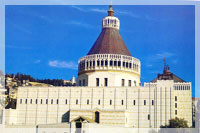 The basilica is one of the world's most holy Christian Liturgical sites, built on the traditional site of the annunciation by the Angel Gabriel of the birth of Jesus. The central grotto is believed to have been the home of Mary.
The basilica is one of the world's most holy Christian Liturgical sites, built on the traditional site of the annunciation by the Angel Gabriel of the birth of Jesus. The central grotto is believed to have been the home of Mary.
The basilica was built in 1969 on the site of crusader and Byzantine remains. This church is a must for almost any Catholic and Orthodox pilgrims.

CANA
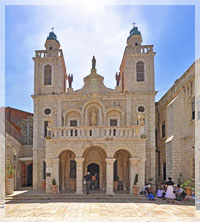 The Arab village of Kafr Cana in the Lower Galilee is identified in Christian tradition as Cana of the Galilee. Here, according to tradition, Jesus performed the miracle of the wine, when he went to a wedding of a poor couple and turned water into wine.
The Arab village of Kafr Cana in the Lower Galilee is identified in Christian tradition as Cana of the Galilee. Here, according to tradition, Jesus performed the miracle of the wine, when he went to a wedding of a poor couple and turned water into wine.
In the 17th century Kafr Cana was officially recognized by the Vatican, and the pope officially confirmed that Kafr Cana is indeed Cana of the Galilee. Following this recognition the village was added to the list of Christian holy places. Some researchers identify Kafr Cana with the Kana mentioned in the ancient Egyptian Amarna letters (from about 4,000 years ago).
One way or the other, in the Roman-Byzantine period (1,000-2,000 years ago), there was a large Jewish community here, but apparently by the Mameluke period (about 800 years ago) most of the residents of Kafr Cana were Christian, although there was still a Jewish community here, too. Today most of the residents of Kafr Cana are Muslim.
In the center of the village are a few remains of ancient buildings and burial caves. The villagers have built new houses to the southeast and northeast of the ancient village. The most important site in the village is the Catholic Church, built in 1879, on the traditional site of the miracle of the wine. Beside this church is the Greek Orthodox church of St. George, built in 1886, which house two stone jars that Greek Orthodox followers believe are the jars in which Jesus performed the miracle of the wine.
There is also a church named after St. Bartholomew, built, according to tradition, on the site of the home of Nathaniel of Cana (St. Bartholomew), one of Jesus' disciples.
Some 200,000 tourists visit Kafr Cana annually. Inspired by the miracle of the wine, a tradition has developed of holding weddings here, as well as renewing wedding vows to strengthen a marriage, and visitors customarily buy wine here. The street of the churches, in the center of the village, has been renovated and a promenade has been built, connecting the religious centers. Small plazas have been built along the promenade, with rest spots, and the facades and courtyards of the buildings have been attractively refinished. Infrastructure has been laid alongside the promenade for commercial and hotel facilities, so that visitors will be able to combine the comforts of modern tourism with their religious experience.

CAPERNAUM
 At Capernaum – known as Jesus' "own town" (Matt. 9:1) – "walking where Jesus walked" takes on a thrilling new meaning. As you sit on the stone benches of Capernaum's ancient synagogue, you'll be reminded that right here, Jesus taught (Mark 1:21; John 6:59) and healed a man possessed by an evil spirit (Mark 1:23-27).
At Capernaum – known as Jesus' "own town" (Matt. 9:1) – "walking where Jesus walked" takes on a thrilling new meaning. As you sit on the stone benches of Capernaum's ancient synagogue, you'll be reminded that right here, Jesus taught (Mark 1:21; John 6:59) and healed a man possessed by an evil spirit (Mark 1:23-27).
It was the synagogue on this very spot, whose foundations you can still see, which Luke says was built by the centurion whose servant Jesus later healed (Luke 7:3-5). Jesus also raised from the dead the daughter of this synagogue's leader (Luke 8:49-53).
The ruins that surround you here, from homes with ordinary tools of daily life to intricately decorated stone carvings, are powerful reminders of Jesus' prediction about this town (Matt. 11:23). A highlight is Peter's house, where Jesus healed Peter's mother-in-law (Matt. 8:14-15; Mark 1:29-31). Peter's house was a simple dwelling, like many others that archaeologists have unearthed in this small fishing and farming village. But unlike the others, here Christian pilgrims over the centuries left no less than 131 inscriptions on the walls. Jesus' name appears frequently, as does Peter's, along with crosses, pilgrims' names and blessings.
Eventually, in the mid-fourth century, a large church was built, whose mosaic floor you can still see, with Peter's house as its centerpiece. Some years ago a modern church went up above the ruins. These walls, old and new, attest to the continuing reverence for the site of one of the best-loved healing stories of the Gospels, here in the heart of Capernaum, the center of Jesus' Galilee ministry.

CHAPEL OF ASCENSION
 There are three Churches of the Ascension built on the Mount of Olives, and this chapel (now a mosque) claims to be the oldest.
There are three Churches of the Ascension built on the Mount of Olives, and this chapel (now a mosque) claims to be the oldest.
Its foundations date back to the time of Poimenia at the end of the fourth century, but, like the Church of the Holy Sepulchre, the current structure is of crusader origins.

CHAPEL OF ST.PETERS PRIMACY
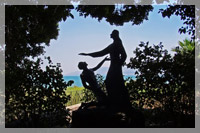 This church is located roughly 500 yards from the Multiplication of the Loaves and Fishes Church in the same compound of "seven springs". It commemorates the post-resurrection sighting of Jesus in John's Gospel when, seeing the disciples fishing, he calls them over to the lake side to have breakfast, at the same time forgiving Peter for his weakness on the night of the trial. The church is built over the rock where the fire was lit.
This church is located roughly 500 yards from the Multiplication of the Loaves and Fishes Church in the same compound of "seven springs". It commemorates the post-resurrection sighting of Jesus in John's Gospel when, seeing the disciples fishing, he calls them over to the lake side to have breakfast, at the same time forgiving Peter for his weakness on the night of the trial. The church is built over the rock where the fire was lit.

CHRIST CHURCH
Christ Church, near Jerusalem's Jaffa Gate, was the first Protestant church in the Middle East, established in the nineteenth century, when the winds of modernity first began to blow in this ancient land.
Christ Church was built by the Church of England following the purchase of the land in 1833, in what was and still is an excellent location. It holds regular services in several languages and runs a charming guesthouse.
From an architectural point of view, it is a very unusual house of prayer. Neo-Gothic in style, it contains no overt Christian symbols, but rather is replete with Old Testament ones. The intricate stained glass windows, for example, depict some of the Seven Species of Deuteronomy 8:8 and other Old Testament themes; the Ten Commandments are inscribed in Hebrew behind the wooden altar and paneling behind the altar is reminiscent of the Torah ark in a synagogue.

EIN KAREM
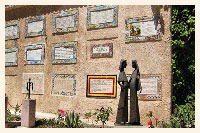 A picturesque lane in a village outside of Jerusalem, Ein Karem – the traditional "town in the hill country of Judea" (Luke 1:39) – leads to the Church of John the Baptist, where Christians have marked John's birthplace for over 1,500 years.
A picturesque lane in a village outside of Jerusalem, Ein Karem – the traditional "town in the hill country of Judea" (Luke 1:39) – leads to the Church of John the Baptist, where Christians have marked John's birthplace for over 1,500 years.
The vestiges of many centuries of destruction and rebirth can all be seen here; mosaics attest to earlier houses of worship, while the inner walls of today's church, rebuilt in 1674, are covered with beautiful blue and white Spanish tiles.
The most ancient part of this venerable landmark is downstairs. It is the cave where early Christians gathered to worship on the site of the house of Elizabeth and Zachariah. Here, depicted in marble, are John's birth, his naming, and his baptism of Jesus in the Jordan. After your visit, the church courtyard, shaded by pungent pepper trees, is the perfect place for prayer and Bible study.

CHURCH OF MARY MAGDALENE
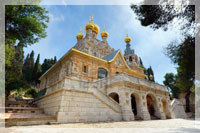 Visitors entering the large green gate of the Russian Orthodox Church of Mary Magdalene near the foot of the Mount of Olives feel they are not only stepping back in time, but entering another country. Many Jerusalem churches give this feeling, and for good reason: they are the legacy of the nineteenth century, when the crowned heads of Europe all graced the Holy City with grand buildings in the styles of their own country.
Visitors entering the large green gate of the Russian Orthodox Church of Mary Magdalene near the foot of the Mount of Olives feel they are not only stepping back in time, but entering another country. Many Jerusalem churches give this feeling, and for good reason: they are the legacy of the nineteenth century, when the crowned heads of Europe all graced the Holy City with grand buildings in the styles of their own country.
The church reflects much Russian history – it was built in 1895 by Czar Alexander III in memory of his mother Maria Alexandrovna, and named for her patron saint, Mary Magdalene. With its seven magnificent onion-topped, glinting gold domes in the style of Moscow's sixteenth-century churches, this is one of the city's best-known sacred landmarks.
The most impressive aspects of the visit are the blooming gardens and the breathtaking view of the Golden Gate, framed by cypress and olive trees.

HOLY SEPULCHER CHURCH
 Easily the most celebrated, yet most contentious, church in Christendom, the Holy Sepulchre contains the traditional sites of the crucifixion and resurrection of Jesus under one roof.
Easily the most celebrated, yet most contentious, church in Christendom, the Holy Sepulchre contains the traditional sites of the crucifixion and resurrection of Jesus under one roof.
The site was rediscovered in the corner of the western forum of the Hadrianic city Aelia Capitolina by Queen Helena, Constantine's mother, who knocked the temple down and built a huge basilica, which was dedicated on Easter day in the year 326.
The church was partially rebuilt in the next century by Justinian, and remained untouched until 1009, when the mad caliph Hakim destroyed virtually all of it. It was patched up by a Monk called Robert, but when the Crusaders came across the city, around the year 1099, the church was rebuilt to only half of its original size, and thus it stands today.

CHURCH OF VISITATION
 The village of Ein Karem has had a long Association with John the Baptist, being his reported town of birth.
The village of Ein Karem has had a long Association with John the Baptist, being his reported town of birth.
This church honors the visit paid by Mary, Jesus' mother, to Elizabeth, John's mother. As this is the point at which Mary poured forth her song of praise, the Magnificat, the church is beautifully decked out with tiled representations of that canticle in just about every known language.

CITY OF DAVID
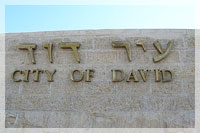 Four thousand years of history have been revealed in the City of David, where visitors gain important understanding of Jerusalem's unique place in the world.
Four thousand years of history have been revealed in the City of David, where visitors gain important understanding of Jerusalem's unique place in the world.
The City of David Visitor Center has been built overlooking the fascinating remains of a monumental building some believe was the palace of Jerusalem's kings.
A huge water cistern evokes the story of Jeremiah's imprisonment (Jer. 38:6). The touring route descends via Warren's Shaft and more recently discovered tunnels to the Gihon Spring where Solomon was crowned (1 Kings 1:33). The walk then continues to remnants of the actual Siloam Pool from Second Temple times, where the blind man healed by Jesus washed (John 9:11). The adventurous can then slosh 1,500 feet through Hezekiah's Tunnel (2 Chron. 32:30), or take the "dry walk" through another ancient conduit.
Wet or dry, the City of David is a must-see on any Jerusalem itinerary.

PLAINS OF SHARON
 For Isaiah, the Plain of Sharon was the ultimate symbol of beauty. It was also the region from which Christianity set sail to the world. Today, the Sharon region boasts beautiful farmland as well as flourishing cities, while the biblical names endure and the sites still tell their ancient tales.
For Isaiah, the Plain of Sharon was the ultimate symbol of beauty. It was also the region from which Christianity set sail to the world. Today, the Sharon region boasts beautiful farmland as well as flourishing cities, while the biblical names endure and the sites still tell their ancient tales.
Lydda (today called Lod) in the southern Sharon is where Peter healed Aeneas, and "all those who lived Lydda and Sharon saw him and turned toward the Lord" (Acts 9:34).
In the seaport of Joppa, where King Hiram of Tyre sent the Cedars of Lebanon to Solomon to build the Temple, Peter raised Tabitha from the dead (Acts 9:36-40). Joppa was also the scene of Peter's rooftop vision at the house of Simon the Tanner (Acts 10:9-16). The vision led him straight to the great city of Caesarea in the northern Sharon, and to Cornelius, who, thanks to Peter, became the first gentile to accept Christianity.
From Caesarea's busy port, ships set sail far and wide; many Christians must have embarked on their journey from here, carrying their new faith to distant lands. Paul's missionary journeys brought him to Caesarea (Acts 18:22; 21:8); he was also imprisoned there, appeared before King Agrippa II, and then boarded a ship for Rome (Acts 25 and 26).
The Sharon, with its beauty, historical and spiritual riches, is still a region of splendor and of glories yet unseen (Isaiah 35:2).

COENACULUM
 The Coenaculum is the traditional place of the "upper room," where the Last Supper was held. The crusaders, being literalists, made sure their chapel was on the second-story of the building and "David's tomb" was subsequently installed below. It is also associated with the room belonging to John Mark's mother in which the disciples were baptized in the Holy Spirit, but this is difficult to verify.
The Coenaculum is the traditional place of the "upper room," where the Last Supper was held. The crusaders, being literalists, made sure their chapel was on the second-story of the building and "David's tomb" was subsequently installed below. It is also associated with the room belonging to John Mark's mother in which the disciples were baptized in the Holy Spirit, but this is difficult to verify.
In 1335, 80 years after the collapse of the crusader kingdom, the Franciscans, who had remained at their posts as Custodians of the Holy Land, bought the site from the Caliphate. They were involved in an argument with the Jews over David's tomb in the 15th century, only solved by the Muslims taking charge and turning all of it into a mosque in 1551. Today Christians and Jews still share the building

TOMB OF KING DAVID
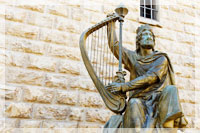 The Tomb of King David is a recent (mediaeval) site which could not be the actual burial place as King David was buried in the City of David which lies further east and south. As it is, the tomb is strangely situated in the same crusader building that houses the Coenaculum.
The Tomb of King David is a recent (mediaeval) site which could not be the actual burial place as King David was buried in the City of David which lies further east and south. As it is, the tomb is strangely situated in the same crusader building that houses the Coenaculum.
The constant trickle of Jewish pilgrims to the site increases significantly on the religious festival of Shavu'ot (pentecost), traditionally the anniversary of the death of King David.

DAVID'S TOWER
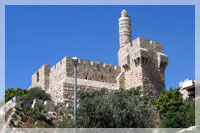 Containing absolutely no connection with King David, this fortress was built by Herod the Great on Hasmonaean foundations to try and secure Jerusalem's northern wall, always the weakest point of its defences. Its three towers were named after his three favourite people: Miriam (his wife), Phasael (his brother) and Hippicus (his friend). Today only the base of the tower of Phasael survives from that time.
Containing absolutely no connection with King David, this fortress was built by Herod the Great on Hasmonaean foundations to try and secure Jerusalem's northern wall, always the weakest point of its defences. Its three towers were named after his three favourite people: Miriam (his wife), Phasael (his brother) and Hippicus (his friend). Today only the base of the tower of Phasael survives from that time.
The fortress, due to its colossal size, was only partially destroyed by the Romans during the first Jewish Revolt (AD 66-70) and survived as a fortress through successive Islamic, Crusader and Turkish periods right up to the First World War. In fact, it was from those steps that British General Allenby declared the freedom of Jerusalem from Turkish rule.

DOME OF THE ROCK
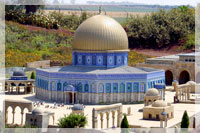 This magnificent octagon that dominates the Old City is a shrine for Islam's third most holy site. The piece of black stone it covers is the mountain where Abraham tried to sacrifice Ishmael (not Isaac as Jews and Christians believe), the site of the temple of Solomon, and the place from whence Mohammed departed skywards for his famous encounter with the heavenly—"The Night Journey".
This magnificent octagon that dominates the Old City is a shrine for Islam's third most holy site. The piece of black stone it covers is the mountain where Abraham tried to sacrifice Ishmael (not Isaac as Jews and Christians believe), the site of the temple of Solomon, and the place from whence Mohammed departed skywards for his famous encounter with the heavenly—"The Night Journey".
The building took three years to complete, from 688 to 691, and was erected as a deliberate snub to Christians and Jews, whose faith Islam was supposed to supersede. The location had borrowed Judaism's heritage and most holy sight—the Temple Mount— the building was constructed to have a larger dome than that of the Holy Sepulchre's, and Syrian Christians were forced to Lay mosaics inside containing verses taken from the Koran about Christian misguided belief in the Trinity.
The Dome of the Rock has survived all earthquakes thus far, being built firmly on rock, and has never been destroyed, merely renovated. The new external tiling was put on in 1963 and the dome was re-gilded in 1993-94.

DOMINUS FLEVIT
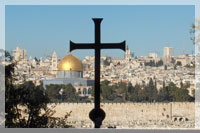 Dominus Flevit (meaning "The Lord Wept") is a beautiful teardrop chapel which was only built in 1955 over the site of a Byzantine construction. It commemorates the occasion of Jesus looking at the city of Jerusalem and, when realizing that it was going to destroy itself by violence, weeping bitterly.
Dominus Flevit (meaning "The Lord Wept") is a beautiful teardrop chapel which was only built in 1955 over the site of a Byzantine construction. It commemorates the occasion of Jesus looking at the city of Jerusalem and, when realizing that it was going to destroy itself by violence, weeping bitterly.
In the grounds are the remains of the Byzantine church, as well as part of the first century necropolis that surrounded the city. The view is extraordinary.

DORMITION ABBEY
 This marvelous church is a landmark of the city of Jerusalem, and is the site where the Virgin Mary is said to have died, or fell into 'eternal sleep'. Its Latin name is "Dormition Sanctae Mariae" (Sleep of St. Mary).
This marvelous church is a landmark of the city of Jerusalem, and is the site where the Virgin Mary is said to have died, or fell into 'eternal sleep'. Its Latin name is "Dormition Sanctae Mariae" (Sleep of St. Mary).
The current church and Monastery, owned by the German Benedictine Order, was consecrated in 1906. It was noticeably damaged during the battles for the city in 1948 and 1967. In the crypt of the church lies a recumbent statue of the Virgin in death, and the rotunda above is noticeable for its glorious mosaic zodiac, a most unusual addition to a Christian church.

DOMUS GALILLEAEA
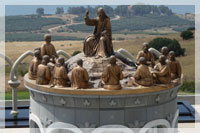 Visitors who enter the Domus Galilaeae center, atop the Mount of Beatitudes overlooking the Sea of Galilee, can immediately feel the power of the inscription in the bright and airy lobby: "The Lord was waiting for you on this mountain."
Visitors who enter the Domus Galilaeae center, atop the Mount of Beatitudes overlooking the Sea of Galilee, can immediately feel the power of the inscription in the bright and airy lobby: "The Lord was waiting for you on this mountain."
Domus Galilaeae was founded by the Neo-Catechumenal Way, a movement established in the 1960s to lead people to understand Christianity the way the first Christians did, as adults.
The new center, where the movement's members stay on a week-long Holy Land tour following study and spiritual preparation, is rich in symbolism. The chapel has a magnificent painting by the movement's founder, Kiko Argüello, combining Eastern and Western Christian symbols and paying homage to the Church's Jewish roots.
The uniquely designed library, specializing in books about the Sermon on the Mount, has a Torah scroll as its centerpiece.
Domus Galilaeae invites visitors of all denominations to tour the center and learn more about the movement.

ECCE HOMO ARCH
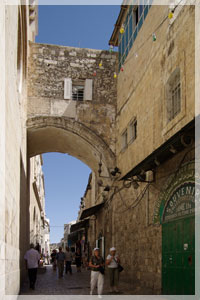 This church is built on the edge of the Eastern forum of Hadrian's city of Aelia Capitolina. The archway built to crown the entrance to the forum was of typical Roman pattern -one arch for wheeled traffic in the middle flanked by two for pedestrians - and half of it stands today. The central arch still spans the current street, just much lower down, and the northernmost pedestrian arch appears in the church as part of the chancel screen.
This church is built on the edge of the Eastern forum of Hadrian's city of Aelia Capitolina. The archway built to crown the entrance to the forum was of typical Roman pattern -one arch for wheeled traffic in the middle flanked by two for pedestrians - and half of it stands today. The central arch still spans the current street, just much lower down, and the northernmost pedestrian arch appears in the church as part of the chancel screen.
The church was so named because it was believed that Pilate delivered his speech to the crowds beginning "Behold the Man" during Jesus' trial on that spot - wholly inaccurate as the site dates from 135AD - one hundred years after Jesus or Pilate.

ELIJAH'S CAVE
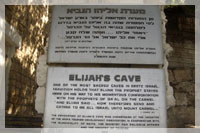 Elijah's Cave in Haifa brings visitors both the sanctity of a Jewish holy place and the sharing of traditions for which Haifa is famous. The stairway to the cave, located off Allenby Street in lower Haifa, reveals spectacular vistas of the city.
Elijah's Cave in Haifa brings visitors both the sanctity of a Jewish holy place and the sharing of traditions for which Haifa is famous. The stairway to the cave, located off Allenby Street in lower Haifa, reveals spectacular vistas of the city.
The site was first mentioned in a letter written from the land of Israel in 1626 by a Jewish visitor telling about the holy places, which described "Elijah's large and magnificent cave" on Mount Carmel. Here, according to legend, Elijah came to pray before challenging the prophets of Baal and calling down fire from heaven (I Kings 18). The cave has a Torah Ark and a space in the ceiling where visitors insert prayer notes.
You may find a few people quietly praying here, or a lively celebration in honor of a circumcision or a three-year-old boy's first hair cut. The right-hand wall of the cave, which in various periods has been sacred to Christians and Muslims as well, is covered with ancient Greek inscriptions, and one in Hebrew, along with two seven-branched candelabra

EMMAUS
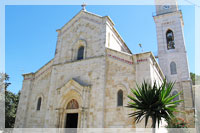 The ruins of a twelfth-century church now mark the village of Emmaus, toward which two disciples were walking when Jesus appeared to them after the Resurrection (Luke 24:13-28). Walking the road with Jesus has become a powerful symbol of Christian life, and Emmaus is an excellent place to ponder it.
The ruins of a twelfth-century church now mark the village of Emmaus, toward which two disciples were walking when Jesus appeared to them after the Resurrection (Luke 24:13-28). Walking the road with Jesus has become a powerful symbol of Christian life, and Emmaus is an excellent place to ponder it.
The massive stones of the church, just off the Jerusalem-Tel Aviv highway, are a dramatic backdrop for prayer and reading the story, which continues with Jesus breaking bread with the disciples.
There is more than one "Emmaus" because of differing distances from Jerusalem given in various versions of Luke, but early Christian scholars believed it was here, overlooking the Valley of Ayalon (Josh. 10:12).
The town, where archaeologists have unearthed interesting Roman and Byzantine remains, first became known for a great victory of the Jews over the Greeks in 165 BCE.

SEA OF GALLILEE
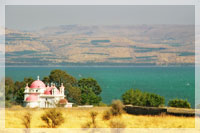 Time seems to have come to a stand-still where the green hills of the Galilee slope down to the most famous lake in the Bible. That is the secret of the power of this region to move Christian visitors. You don't have to close your eyes to picture Jesus here – you have to open them.
Time seems to have come to a stand-still where the green hills of the Galilee slope down to the most famous lake in the Bible. That is the secret of the power of this region to move Christian visitors. You don't have to close your eyes to picture Jesus here – you have to open them.
As Matthew 4:13 tells us, Jesus went from Nazareth, in the heart of Galilee, to Capernaum by the shore of the lake they called Genesaret. Here he gathered his first disciples – fisherman whom he found casting their nets from the shallows (Matt. 4:18). You can walk along that shore, in the very places where Jesus and the disciples trod, and see the Bible spring to life.
You'll want to rise early here, perhaps at dawn, when the ancient fishermen used to come home with their catch – or without it. As you watch the frenzy of the fish feeding close to the shoreline, you can understand why Jesus chose fishermen for his first apostles: "...the kingdom of heaven is like a net that was let down into the lake..." (Matt. 13:47). This was the backdrop for the feeding of the 4,000 (Matt. 15:32-37) and of the 5,000 (Mark 6:39-43), with a few loaves and fishes. The beloved stories of the miraculous catches of fish are remembered here, perhaps especially that in John 21, when Peter was reconciled to Jesus (John 21:15-17). The drama of the demoniacs in the land of the Gadarenes (Matt. 8:28-33) takes on new meaning as you stand on the craggy cliff marked centuries ago by Christians as the place where the pigs flew into the lake. This site, lost for centuries, was rediscovered and restored only a few decades ago by Israeli archaeologists.
Christian visitors love to walk the stone path created by the Ministry of Tourism along the northern part of the lake, from near Capernaum to the place of the multiplication of loaves and fishes. As you do, you can't help but feel the land vibrate with ancient stories of glory and simple faith. Look around you – in winter and spring the "lilies of the field" (Matt. 6:28) abound, and seeds thrive in their beds of good soil (Mark 4:8). In late summer and fall, the choking thorns of the sower's parable still overtake those same fields, just as Jesus described it (Mark 4:7).
In northern Galilee, mountains loom up on either side of the valley highway that once led to the ancient kingdoms of the north. Here you will find Hazor, conquered by Joshua and built up by Solomon. You will also see Dan, where you can stand at the High Place that despite Jeroboam's best efforts was no match for Jerusalem, and Caesarea Philippi at the headwaters of the Jordan, where Jesus asked his disciples "who do people say that I am?" (Mark 8:27).
These are the moments, as you become one with the memories of this beautiful land, that understanding comes to you, to accompany you ever after on your spiritual walk.

GOLDEN GATE
 This gate on the east-side of the Temple Mount would have been an entrance for priests as they went up to pray. All three monotheistic faiths have entertained traditions about their messiah going up through the gate before declaring judgment from the Temple Mount
This gate on the east-side of the Temple Mount would have been an entrance for priests as they went up to pray. All three monotheistic faiths have entertained traditions about their messiah going up through the gate before declaring judgment from the Temple Mount

GARDEN OF GETHSEMANE
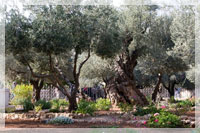 Visitors to of the Garden of Gethsemane are amazed when they learn that the gnarled olive trees they see could have been young saplings when Jesus came here with the disciples on that fateful night after the Last Supper (Matt. 26:36; Mark 14:32; John 18:1). Today the ancient trees rise from manicured flower beds; in Jesus' time this would have been an olive grove where an olive-oil press – Gethsemane in Greek – was located.
Visitors to of the Garden of Gethsemane are amazed when they learn that the gnarled olive trees they see could have been young saplings when Jesus came here with the disciples on that fateful night after the Last Supper (Matt. 26:36; Mark 14:32; John 18:1). Today the ancient trees rise from manicured flower beds; in Jesus' time this would have been an olive grove where an olive-oil press – Gethsemane in Greek – was located.
The impressive Church of All Nations, built in the 1920s over earlier churches, relates the events of this place in brilliantly detailed floor-to ceiling mosaics: Jesus praying alone (Mark 14:35-36); Judas' betrayal of Jesus (Matt. 26:48); the cutting off of the ear of the High Priest's servant (Mark 14:47).
Across the lane is a less-frequented grove, where arrangements can be made for visitors to spend a more private time of worship and contemplation.

GALILLEE BOAT
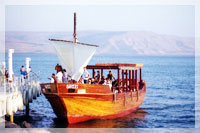 For Christians, the Jesus Boat is one of the most precious and meaningful archaeological treasures in the world.
For Christians, the Jesus Boat is one of the most precious and meaningful archaeological treasures in the world.
On a drought-dried shore of the Sea of Galilee in January 1986, two brothers who were fishermen from Ginosar—called Gennesaret in Jesus' day (Matt. 14:34, Mark 6:53)—spied a mysterious object poking up out of the mud. Twelve days later, an ancient vessel saw the light of day for the first time since it sank nearly 2,000 years ago.
Scholars say it was a combined ferry and fishing boat, and might have even served in a sea battle against the Romans, but for more than a million Christians who have seen it over the years, and for those looking forward to doing so, it will always be "the Jesus boat." While no one knows exactly who rode in the boat or what its purpose was, it serves as a powerful visual reminder of the Gospel stories of Jesus and his disciples, many of whom were fishermen themselves.
After complex restoration, the Galilee Boat now sits above a calm blue-green sea at the Yigal Alon Center at Kibbutz Ginosar. At this superb indoor display, visitors learn that this mainly oak-and-cedar craft was patched repeatedly and lovingly with 12 different kinds of wood, and that these very trees still grow along the walk to the museum.
Sculptor and kibbutz gardener Yuvi Lufan, who along with his brother Moshe discovered the boat, is now part of the living history of the Galilee Boat. "Our parents taught us to love the Sea of Galilee," Lufan says, "and I always knew it would give us a gift. And it did—a legacy that brought something special to the whole world."

HAIFA
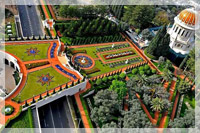 Haifa, which crowns Mount Carmel high over the Mediterranean, can enrich your Israel visit in unexpected ways.
Haifa, which crowns Mount Carmel high over the Mediterranean, can enrich your Israel visit in unexpected ways.
Haifa falls into the inheritance of the sea-faring tribe of Zebulun (Gen. 49:13). For centuries it was only a fishing village, eclipsed by the great city of Akko/Ptolemais (Judges 1:31; Acts 21:7) across the bay. But Christians have always made pilgrimage to the Cave of Elijah, now in the heart of town, and the Carmelites built a monastery here, Stella Maris, "the star of the sea," dedicated to Mary.
In the late 19th century, German Christians settled here, bringing modern life. For the Baha'is, this is also sacred ground. Before World War II, the British built Haifa's port, still a mainstay of Israel's economy, and gave the city a multi-cultural flair. The Jews, Christians and Muslims who comprise Haifa's 270,000-strong population have found ways to coexist that are a model for the rest of the country.

JERUSALEM
 Jerusalem is like no other city, people often say. But what makes it so? Could it be your feeling, as you walk these ancient streets, that you are walking a tightrope between heaven and earth?
Jerusalem is like no other city, people often say. But what makes it so? Could it be your feeling, as you walk these ancient streets, that you are walking a tightrope between heaven and earth?
Jerusalem had two natures, it has long been said: the "heavenly" and the "earthly." Sometimes it may seem to visitors that its "earthly" elements are just like those of any other city – perhaps even more so; as you navigate the Old City streets, and even at its holy places, seeking the spiritual moments you imagined you'd always have, you might occasionally find yourself jostled by the crowds, who seem to have not the slightest bit of respect for your space!
Yet Jerusalem may be where "respect for space" was invented. After all, God said of it: "My Name shall be there" (I Kings 8:29). And you want to come here because you want be on that spot – where tradition says Abraham stood a moment before the angel stopped him from sacrificing his son Isaac. You want to come to Jerusalem because at the Mount of Olives you can behold the city spread out before you, floating like a vision of all time. You want to be here to walk down the Mount of Olives and hear the echoes of crowds shouting "Hosannah!" You want to be able to sense the strengthening of your faith as you pray under the ancient olive trees at the Garden of Gethsemane. You want to stand at Golgotha, and behold an empty tomb. You want to walk up the steps leading to the Temple that Jesus also must have climbed, and where Peter healed a beggar. You want to restore your vision, like the beggar of old at the Pool of Siloam, where every day, under the skilled hands of the archaeologists, the earth yields up the stones that Jesus knew. You want to celebrate here with the Jewish people on the biblical holidays of ascent to the Holy City – Tabernacles, Passover and Pentecost.
You will come because you want to learn what true "sacred space" is. It is here that you can relive like nowhere else the moments when Jesus walked through streets like these, carrying the cross. It dawns on you here how 2,000 years later the crowds still jostle for space, still ignore the needs of others – or offer to help out a stranger with overflowing compassion; the vendors still vie for your attention, and the air is filled with the aromas of cinnamon and myrrh, coriander, cumin and sage. And that is when you realize what "sacred space" is all about.
Because this is what you seek, this is what leads you to Jerusalem, you'll find when you are here that you can move easily between the realms of the earthly and the heavenly, and make the Holy City your own.

JAFFA
 Jaffa is a place for beginnings, both of many tours of Israel, and in the Bible. Jonah's journey, Tabitha's restoration to life, and Peter's conversion of Gentiles all began here. Thus, Jaffa, Tel Aviv's "older sister" boasts bountiful biblical history, along with charming lanes, antiquities, quiet churches, galleries and a picturesque fishing port.
Jaffa is a place for beginnings, both of many tours of Israel, and in the Bible. Jonah's journey, Tabitha's restoration to life, and Peter's conversion of Gentiles all began here. Thus, Jaffa, Tel Aviv's "older sister" boasts bountiful biblical history, along with charming lanes, antiquities, quiet churches, galleries and a picturesque fishing port.
In Jaffa, Peter was divinely led to "think out of the box." The story in Acts 10:5-23, finds Peter on the rooftop of the House of Simon the Tanner, where he had his famous vision (Acts 10:12-13), that led him to preach the Gospel to the gentiles at Caesarea. Peter's resurrection of the righteous Tabitha (Acts 9:36-42) is marked at the Russian Orthodox Church of Tabitha.
Jaffa's landmark Church of St. Peter is off Kedumim Square, where a visitor's center shows off the city's long and fascinating history. At the end of a lane leading through the artists' colony to Summit Park, an archaeological dig reveals a fortress built by the "Pharaoh of the Exodus," Ramses II.
The view of the sea reminds visitors that King Hiram of Tyre sent cedar logs for the Temple to Jaffa, where they were hauled ashore and trundled up to Jerusalem (2 Chron. 2:16).
A plaque on the beach north of Jaffa honors the 157 American Christians from Jonesport, Maine, who landed here on the Nellie Chapin in September 1866, bringing the wood with them to build their houses. The story of the American Colony is told at one of the colony's restored houses in Jaffa, the Maine Friendship House.

MOUNT GILBOA
 Mount Gilboa is part of the lower Galilee's eastern gateway between the Jezreel Valley, Israel's breadbasket, and the Jordan Valley. One of the Galilee's most scenic regions, this 500-meter-high ridge is the site where King Saul and his sons, Jonathan, Abinadav and Malkishua died after a battle with the Philisitines (1 Sam. 31:2-7). This moving story is commemorated by the names of some of the communities and peaks along this 18-kilometer-long mountainous stretch.
Mount Gilboa is part of the lower Galilee's eastern gateway between the Jezreel Valley, Israel's breadbasket, and the Jordan Valley. One of the Galilee's most scenic regions, this 500-meter-high ridge is the site where King Saul and his sons, Jonathan, Abinadav and Malkishua died after a battle with the Philisitines (1 Sam. 31:2-7). This moving story is commemorated by the names of some of the communities and peaks along this 18-kilometer-long mountainous stretch.
The view from Gilboa takes in many visitor sites, including Mount Moreh (Judges 7:1), where Gideon's army assembled; Tel Jezreel, home of Ahab and Jezebel; and the national parks of Ein Harod, where Gideon chose his soldiers (Judges 7:4); Beit Alpha, with its ancient synagogue mosaic and Bet Shean, one of the country's most significant biblical tels, whose Roman-Byzantine ruins are a highlight. Also in the area is Sachne National Park, with a warm spring where you can go swimming. You'll find the Mount Gilboa scenic route – along road 667 south of Beit Shean, from Malkishua to Kibbutz Yizrael – studded with magnificent views in all directions, forests, picnic areas and hiking trails. Some Gilboa communities offer bed-and-breakfast accommodations so you can take full advantage of hiking, cycling and other activities in the region. The mountain's normally mild winter days offer the clearest panoramas, but the greatest attraction in March and April is the blooming of the magnificent Gilboa, a gorgeous purplish blossom so significant that it became the logo of the Society for the Protection of Nature in Israel.

MOUNT OF ANOINTING
This hill on the south slope of the Mount of Olives has two names – the first pleasing, and the other, rather disturbing.
The "Mount of Anointing" recalls that olive oil from the local trees was used to anoint the kings of Judah in biblical times, but the ancients also believed that this was the "hill east of Jerusalem" where Solomon built altars for the idols of his foreign wives (I Kings 11:7; 2 Kings 23:13). Thus they made a bitter pun on the Hebrew word for anointing – mishkha, turning it into the similar-sounding mashkhit – corruption!
In a more optimistic vein, legend also has it that the olive branch the dove brought Noah came from a tree that grew here.
The roof of the mount's Catholic guesthouse, the House of Abraham, affords an unusual perspective of the Temple Mount, the Kidron Valley and Mount Zion.

MOUNT OF BEATITUDES
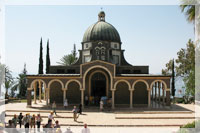 As the name suggests, this is the hill upon which Jesus was said to have preached the "Sermon on the Mount". The lie of the land next to the church forms a natural amphitheatre sloping down to the lake side, so it is more likely that Jesus stood at the bottom of the hill, but this does not detract from the beauty of the church on its crest.
As the name suggests, this is the hill upon which Jesus was said to have preached the "Sermon on the Mount". The lie of the land next to the church forms a natural amphitheatre sloping down to the lake side, so it is more likely that Jesus stood at the bottom of the hill, but this does not detract from the beauty of the church on its crest.

MOUNT OF OLIVES
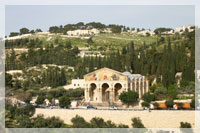 The view from the Mount of Olives is wondrous: the densely packed walled city of Jerusalem embraced by the Hinnom and Kidron valleys, the Golden Gate to Mount Moriah, the Temple Mount, Mount Zion, City of David and more, bring alive both prophecy and Psalms. It is from the Mount of Olives, with its view not only toward the Holy City and its green surroundings, but toward the wilderness, that one understands how Jerusalem got one of its earliest names, Zion (2 Sam. 5:7), which comes from a word meaning desert.
The view from the Mount of Olives is wondrous: the densely packed walled city of Jerusalem embraced by the Hinnom and Kidron valleys, the Golden Gate to Mount Moriah, the Temple Mount, Mount Zion, City of David and more, bring alive both prophecy and Psalms. It is from the Mount of Olives, with its view not only toward the Holy City and its green surroundings, but toward the wilderness, that one understands how Jerusalem got one of its earliest names, Zion (2 Sam. 5:7), which comes from a word meaning desert.
On the eastern slope of the Mount of Olives is Bethany, where a beautiful church marks the home of Lazarus, Mary and Martha (John 1:11), and where visitors can descend and emerge dramatically from the traditional tomb of Lazarus, whom Jesus raised from the dead (John 11:43).
The Palm Sunday Walk, which begins at Bethphage, follows the traditional path Jesus took in his triumphal entry to the Holy City (John 12:13-15). It stops in the quiet garden chapel of Dominus Flevit, marking the site where Jesus wept over Jerusalem (Luke 19:41), and then passes the ancient Jewish cemetery, where the deceased await the resurrection when the Messiah comes to the Mount of Olives (Zach. 14:4). This is an important place to pause and consider that the Mount of Olives is not only a geographical link between the desert and the fertile Jerusalem hills, it is the spiritual link between death and life, also emphasized by the resurrection of Lazarus in Bethany.
In the early days of Christianity, monks came to the Mount of Olives in large numbers, seeking the solitude of its heights where they could deepen their understanding of these and other Scriptural truths.
The Palm Sunday walk culminates in the Garden of Gethsemane, one of the most dramatic sites on a Christian itinerary. This and Olivet's other sites – the Pater Noster ("Our Father") Church, named for the prayer Jesus taught (Matt. 6:9-13), the Dome of the Ascension, the Tower of the Ascension and Viri Galilaei (Acts 1:11) – stir powerful emotions that make this visit an unforgettable spiritual highlight.

MOUNT TABOR
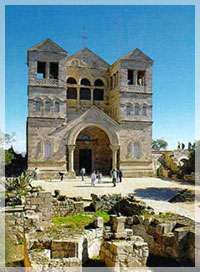 Mount Tabor was an important tribal border in the Hebrew Bible, the place where Deborah routed the enemy, the site of Jesus' transfiguration and the Rabbinic "navel of the world".
Mount Tabor was an important tribal border in the Hebrew Bible, the place where Deborah routed the enemy, the site of Jesus' transfiguration and the Rabbinic "navel of the world".
Even without a history it is still worth ascending for the marvelous view.

MOUNT ZION
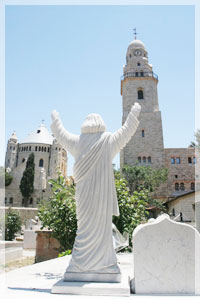 This sanctity of Mount Zion to all faiths can be seen from afar in its monuments, prominent on the Jerusalem skyline. But the significance of this hill just south of Jerusalem's Old City walls begins with its name: Zion is one of the Bible's earliest names for Jerusalem, mentioned when David first established the city (2 Sam. 5:7) as his capital. In fact, the ancient Tomb of David on Mount Zion has been a place of pilgrimage for centuries. The building that houses it has served over time as a church, a mosque, and now a synagogue honoring King David, the "sweet singer of Israel" and the ancestor of the Messiah.
This sanctity of Mount Zion to all faiths can be seen from afar in its monuments, prominent on the Jerusalem skyline. But the significance of this hill just south of Jerusalem's Old City walls begins with its name: Zion is one of the Bible's earliest names for Jerusalem, mentioned when David first established the city (2 Sam. 5:7) as his capital. In fact, the ancient Tomb of David on Mount Zion has been a place of pilgrimage for centuries. The building that houses it has served over time as a church, a mosque, and now a synagogue honoring King David, the "sweet singer of Israel" and the ancestor of the Messiah.
In another part of this ancient complex is the Upper Room, where Christian tradition marks the Last Supper (Matt. 26:18–35) and the events of Pentecost (Acts 2:1–4).
Across from it is the Dormition Abbey, built in 1898 by the German Benedictines, with a triangular roof that is a city landmark. This is the place where Catholic tradition marks the Assumption of Mary to Heaven. The church sanctuary is not only spiritually inspiring; it is the venue for special concerts that attract Jerusalemites of all faiths.
One of the Old City's eight gates, the Zion Gate, opens onto Mount Zion. On a segment of the Ramparts Walk that begins at the Tower of David Museum visitors get a fascinating birds-eye view of Mount Zion, and can then descend at Zion Gate to visit its sites.

MULTIPLICATION OF LOAVES & FISH
 The church on this site is an exact replica of the fourth century basilica built to commemorate the miracle of the feeding of the five thousand. The mosaic floor features one of the most famous motifs in the country - the basket of bread flanked by two fish, as well as a design of wildlife next to the Nile and its water level.
The church on this site is an exact replica of the fourth century basilica built to commemorate the miracle of the feeding of the five thousand. The mosaic floor features one of the most famous motifs in the country - the basket of bread flanked by two fish, as well as a design of wildlife next to the Nile and its water level.
The church is built around a black rock underneath the Altar, reverenced as the rock upon which Jesus blessed and broke the bread.

NAZARETH
 Nazareth was a small village in the time of Jesus, living under the shadow of the neighboring city of Sepphoris. As a result of it being the place where Jesus grew up, Nazareth today is a thriving town while Sepphoris is the neighboring archaeological ruin.
Nazareth was a small village in the time of Jesus, living under the shadow of the neighboring city of Sepphoris. As a result of it being the place where Jesus grew up, Nazareth today is a thriving town while Sepphoris is the neighboring archaeological ruin.
The area around the Basilica of the Annunciation has been extensively excavated and remains of the first century village can be seen by appointment.

MOUNT CARMEL
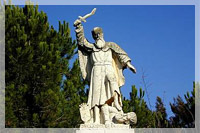 Since the days of yore, Mount Carmel has been a symbol of beauty. It is a particularly suitable location for family hikes and recreation pastimes all year round.
Since the days of yore, Mount Carmel has been a symbol of beauty. It is a particularly suitable location for family hikes and recreation pastimes all year round.
Mount Carmel is not particularly high. Its peak only reaches 546 meters above sea level. Mount Carmel is sprawled between the Menashe Plateau in the south, the Haifa Bay in the north and the Jezreel Valley on the east. Its borders are very clear, and create an independent unit that reaches 32 square kilometers.
Its proximity to the sea gives the mountain large quantities of precipitation, which enable the growth of well developed Mediterranean groves. In spring, bloom is especially diverse and colorful: approximately 670 different species of plants grow on this mountain.
During the Carmel's geological development, many types of rocks were formed. Most of them are marine sedimentary rocks, created as a result of the accumulation of remains of animals in the ancient sea. At that time, when the entire area was submerged in the sea, the Carmel region had several volcanic eruptions that brought Basalt rocks. Next to them, the Carmel also has rocks that were formed by skeletons of marine animals such as shellfish and corals.
The geological fractures that occurred in the area created steep escarpments, the most impressive of which is on the eastern part of the mountain, standing upright over the Jezreel Valley
